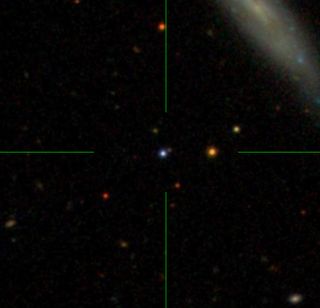A bright quasar, powered by a supermassive black hole, blasts radiation that pushes away clouds of gas in its environment to generate winds that reach speeds of nearly 36 million miles per hour (58 million kilometers per hour). Oh, and the quasar is also almost as old as the universe itself.
The discovery, made by a team of scientists led by University of Wisconsin–Madison astronomers, shows the role that feeding supermassive black holes at the hearts of so-called “active galactic nuclei,” or “AGNs,” may play in the larger sculpting. galaxies around them.
The researchers reached their findings using eight years of data on the quasar SBS 1408+544, located 13 billion light-years away in the constellation Bootes. This data was collected by the Black Hole Mapper Project conducted by the Sloan Digital Space Survey (SDSS). The light from SBS 1408+544 has been traveling around Earth for 13 billion years; that’s almost as long as the 13.8 billion year universe has existed.
Related: A supermassive black hole may be ‘waking up’ in a nearby galaxy
Although supermassive black holes with masses equal to millions, or sometimes billions, of suns are thought to be at the hearts of many galaxies, not all of them give rise to quasars. Quasar black holes are surrounded by matter in a flat, rotating cloud called an “accretion disk” that slowly feeds them material.
The strong gravitational influence of the quasar’s central supermassive black hole causes friction and tidal forces that heat the accretion disk, making it extremely bright. Furthermore, matter that is not fed into the supermassive black hole is directed into the universe’s titanium cores by the strong magnetic field, where it is accelerated to near-light speeds and blasted out as multi-fissure jets. These two jets from each black hole cluster are also accompanied by the emission of electromagnetic radiation.
Not only does this radiation make some quasars brighter than the combined light of all the stars in the surrounding galaxies, but this light also shapes those galaxies and provides an important gauge for astronomers to gauge the influence of black holes on galaxies as a whole.
” Material in that [accretion] The disk always falls into the black hole, and the friction of that drag heats the disk and makes it very hot and very bright,” team leader and University of Wisconsin-Madison astronomy professor Catherine Grier said in a statement on “quasars these are very bright, and because there is a large temperature range from the interior to the outer parts of the disc, their emission covers almost the entire electromagnetic spectrum.”

The bright light from this quasar allowed Grier and his colleagues to track the gaseous carbon wind. This was done by measuring gaps in the broad spectrum of electromagnetic radiation emitted by the quasar, which showed light being absorbed by carbon atoms.
The team found that every time they measured this absorption spectrum over 130 observations of SBS 1408+544, there was a shift from the valid position of the carbon absorption “shadow”. This increased over time as radiation from the quasar pushed away material from around it. This material formed supermassive black hole winds that reached speeds of up to 36 million miles per hour (58 million kilometers per hour), which is about 45,000 times the speed of sound.
“Those changes tell us that the gas is moving faster, and faster all the time,” said team co-leader and University of Wisconsin–Madison astronomy graduate Robert Wheatley. “The wind is accreting because it is being driven by radiation that is emitted from the accretion disk.”

Scientists have suspected they’ve seen a black wind speeding up strangely before, but this is the first time the observation has been backed up with hard evidence. Such cosmic winds are of great interest to astronomers because the gas they spin up serves as the building material for stars. That means, if black hole winds are strong enough, they can cut off star formation, thereby “killing” their host galaxies. They may also become interstellar supermassive black holes, ending their days as quasar machines.
That can turn active galaxies into quiescent galaxies like the Milky Way, which, in addition to forming stars at a slower rate, also has a “sleeping giant” black hole at its heart. Sagittarius A* (Sgr A*), our black hole, is surrounded by objects so small that its diet of gas and dust is equivalent to a human eating a grain of rice every million years. Alternatively, winds from supermassive black holes could compress the gas instead of pushing it away, which would lead to the formation of stars in their star clusters.
Black hole winds like the ones seen by the team can also travel outside the outskirts of their galaxies, affecting neighboring galaxies and, ultimately, supermassive black holes in the vicinity and center of those galaxies.
“Supermassive black holes are huge, but they are very small compared to their galaxies,” Grier said. “That doesn’t mean they can’t ‘talk’ to each other, and this is one way of talking to another that we have to be responsible for when we show the effects of these types of black holes.”
The team’s research was published in June in the Astrophysical Journal.
#black #holes #supermassive #wind #blowing #million #miles #hour #draw #entire #galaxy